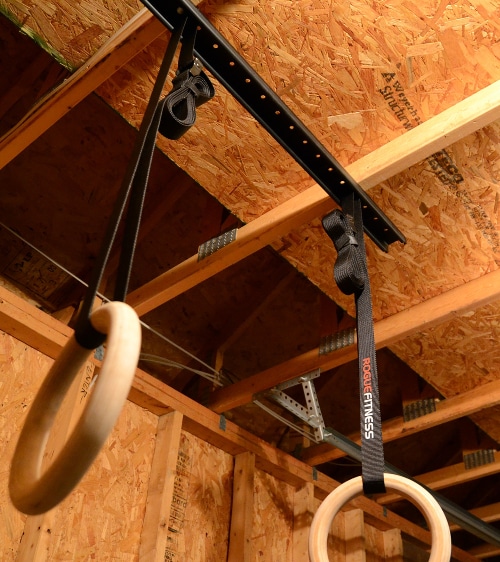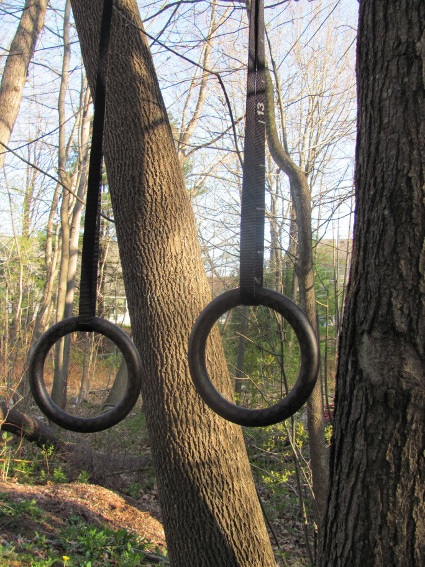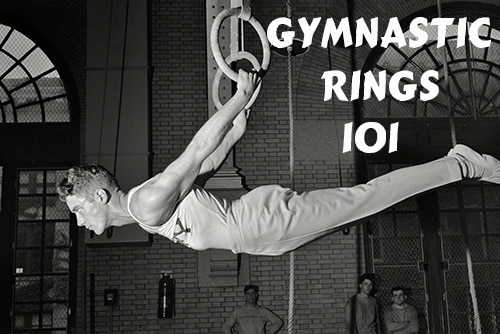
Editor’s Note: This is a guest series from Ryan Hurst.
If you’ve been following the Art of Manliness for a while, you know how Brett and Kate have worked hard to bring us back to a time when the qualities of being a man meant strength, integrity, and pulling your own weight.
And the last part wasn’t just metaphorical, as it used to be commonplace back in the early days of organized exercise for people to work on gymnastic skills for strength and conditioning.
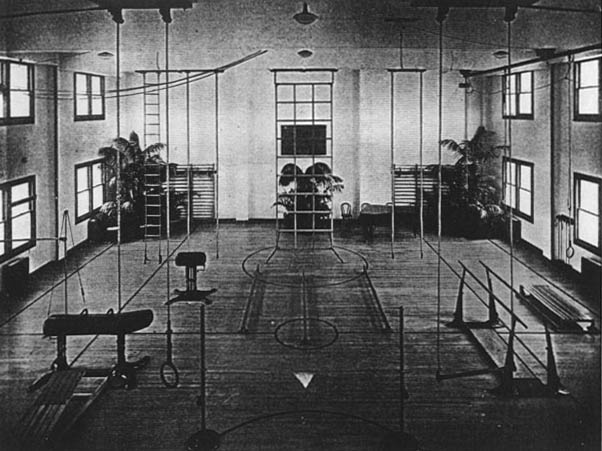
Though physical culturists of the 1940s and 50s still incorporated hand-balancing and rings training into their routines, the general public lost sight of their use in exercise. Rings became a mere spectator sport, and we watched Team USA gymnastics every four years in the Olympics.
But it’s great to see that the pendulum has swung again and gymnastic-style training, particularly on the rings, has made a comeback for non-Olympians’ use, with a simple desire to gain strength and skill with no particular ambitions of standing at the top of a podium.
Why Make Rings Training Part of Your Exercise Routine?
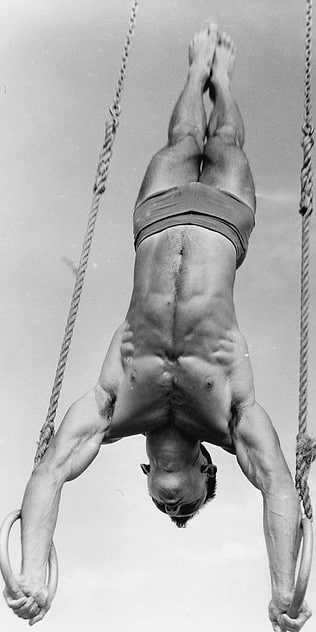
The unique nature of gymnastic rings, and the exercises that can be performed with them, provide benefits beyond those of barbells or pulley machines.
One benefit of the rings is their inherent instability. Independently swinging from a long strap, the rings will move at the slightest touch. This instability forces you to concentrate every second that you are on the rings in order to keep from swaying. It can be difficult enough to pull and press your weight on a fixed bar, let alone on two rings that wiggle around! This difficulty translates into building more strength and muscle in your upper body and core.
Transitioning your body around the rings from a variety of positions requires a significant amount of upper body strength and control. Yes, you can gain a lot of strength with bodyweight exercises and of course from lifting weights, but the instability of the rings, along with the combination of movements, can be an entirely different demonstration of strength.
Skill work on gymnastic rings integrates strength and coordination training in a way that’s much harder to achieve with other equipment, and it gives you a lot of bang for your buck with regards to training time. It’s very common to hear of strong and fit people that exercise with weights and machines all the time, but are humbled and amazed by how difficult it is to perform even the most basic rings exercises. It is intense training that only requires a few movements to equal the impact of a dozen other regular exercises available in the gym.
Also, in terms of space requirements and portability, nothing compares to the great workout you’ll get from this easy-to-carry and simple piece of equipment.
Over the next few days, I’ll share everything you need to know about how to get started on the rings. From which rings to get, to how to set them up, to the best exercises to start with, and finally, where to go once you’ve mastered the basics.
What Should I Buy To Get Started?
It used to be difficult to find gymnastic training rings for the layman. The only options were the very expensive, standard wooden gymnastic rings meant for gymnastics centers and competitions, or plastic rings that weren’t priced much better, or the metal rings commonly seen in playgrounds.
Now, due to the resurgence of ring training and the entrepreneurial spirit that follows such trends, there is a better selection of rings at very reasonable prices.
Now, what are the differences between the various styles of rings?
I wouldn’t recommend metal, playground-style rings for anything beyond simple pull-ups and dips, as they don’t offer the kind of traction you’ll need to smoothly transition from below the rings to above, and vice versa.
As for the difference between wood and plastic, it’s a pretty significant difference in terms of feel, traction, and heft. Plastic rings are more slippery (though less so than metal) and the decreased weight can make them feel less substantial in your hands. This is a valid concern, considering you’ll be throwing your weight around on them. Wood rings tend to simply “feel” better, and tend to age better than plastic when properly maintained.
Plastic rings are definitely cheaper and are nearly indestructible. Yet ultimately, I recommend getting wooden rings. The added expense is worth it if you plan on training with the rings for a long time. The specific rings I recommend are Rogue wooden rings; but really, just find what you’re most comfortable with.
Where Should I Hang Them?
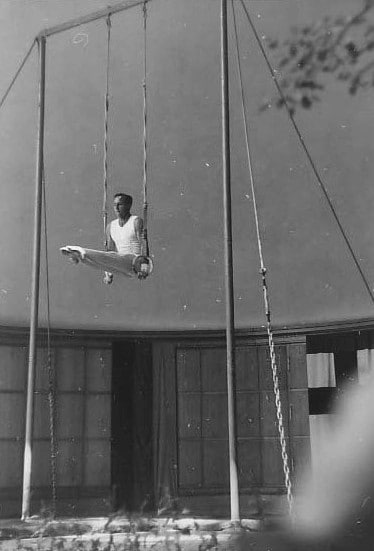
When you get your rings, you’ll notice that it’s just the rings and straps. That’s part of what makes this equipment so versatile. All you do is secure the straps (over a bar, through mounted hooks, etc. — more details below), and you’re set.
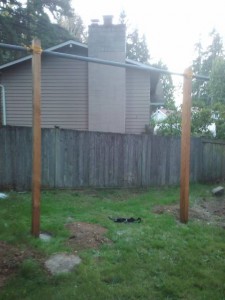
You can build your own outdoor frame for doing your rings exercises.
Ideally, you should find a place where you can hang them and have enough clearance and space to perform all of the exercises that involve being above the rings while still maintaining a height where you can perform pull-ups with a straight body.
We recommend finding a space where you can hang your rings 9-13 feet high. You’ll want to give yourself enough room (both height and width) to adequately perform the exercises (especially the straight body movements). Also, make sure your straps are long enough to let your rings hang low (when you need them to) so that you can do the push-ups, planks, mountain climbers, etc. For width, you’ll want to set your rings about shoulder-width apart.
There are a variety of options for hanging your rings, from the simple to the fairly elaborate. I’ll talk about the most common options below:
Doorway Pull-up Bar
A doorway pull-up bar allows for some good exercises with the rings, but you won’t be able to perform some of the transitions and movements around the rings without some adjustments. By that, I mean you can set the rings up to do dips and pull-ups, but you’ll have to bend your knees for the full range.
You can also perform the exercises in a tuck (knees bent and in front of your chest) or an L-sit position (hips flexed and legs straight out in front of you), which gives some added difficulty.
There would also be restrictions because of the width of the doorway, which would limit some wider pull-up options, as well as some other pulls which require your hands to be out to the side. This isn’t to say you couldn’t get a great rings workout with this set-up, but you will have to forego some of the exercises that make the rings such a worthwhile piece of equipment.
If you’re using a doorway pull-up bar, we recommend that it be the variety that bolts into the frame versus the variety that just uses bodyweight to secure itself.
Pull-up Bar on Power Racks
This setup can be a great option for those with power racks in their garage or when going to your local gym/health club. They are generally taller than doorway pull-up bars, and wider as well.
Mounted on Ceiling or Rafters
This would be an ideal situation for training at home, if possible. Just be very careful with the installation and make everything as solid and secure as you can. The worst thing that could happen would be a materials failure when you are on the rings with your head facing down. Please be vigilant and only do this if you are absolutely sure you can make it safe, or hire someone who can.
Outdoor Options
Swingsets, monkey bars, football uprights, trees, railings, etc. — the outdoor options include basically anywhere there is a solid structure with enough height. The cons are the variability of the weather and regularity of access, but the pros are being outside and able to take your rings with you when traveling. Click here for a tutorial on how to construct your own rings frame outdoors.
Tomorrow, we’ll give you a primer on the basic ring grips.
Read the Other Articles in the Series:
- Why to Use Rings, How to Buy Them, and Where to Hang Them
- How to Grip the Rings
- A Beginner’s Routine and FAQs
- How to Perform a Muscle-Up
_________________________
Ryan Hurst is a former junior national level gymnast and holds several black belts in Japanese martial arts, along with many years of experience teaching strength and skills work that combine all the aspects of his diverse knowledge base. He is a co-founder of GMB Fitness (http://gmb.io), which specializes in teaching body skill development to people of all athletic levels.
He also provides a free Ultimate Guide to Rings Training for beginners that takes you step-by-step into all the benefits of rings training.
Tags: Exercises

